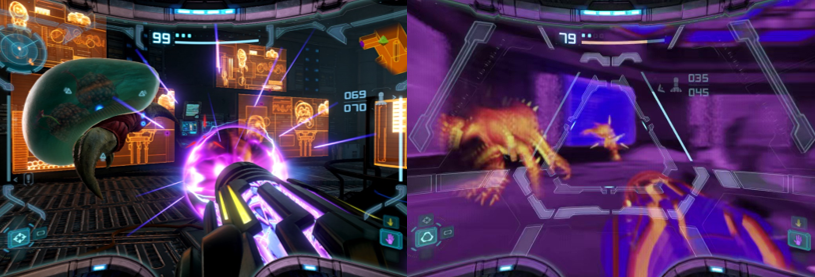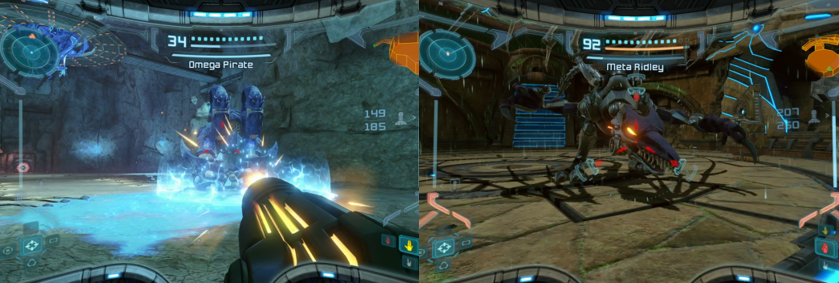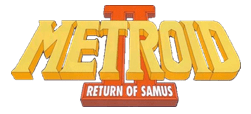January sees the celebration of two notable dates in science-fiction history, with January 2 christened “National Science Fiction Day” to coincide with the birth date of the world renowned sci-fi writer Isaac Asimov, and HAL 9000, the sophisticated artificial intelligence of Arthur C. Clarke’s seminal 2001: A Space Odyssey (1968), being created on 12 January.
Released: 8 February 2023
Originally Released: 18 November 2002
Developer: Retro Studios, Iron Galaxy Studios, et al
Original Developer: Retro Studios
Also Available For: GameCube, Nintendo Wii, Nintendo Wii U
The Background:
In August 1986, Nintendo introduced gamers to Samus Aran, the kick-ass bounty hunter protagonist of their Metroid series (Various, 1986 to present). Praised for its challenging gameplay and eventually lauded as one of the greatest games ever, Metroid helped popularise the “Metroidvania” sub-genre. Following the largely divisive Game Boy-exclusive sequel, Metroid made a universally acclaimed comeback on Nintendo’s ground-breaking 16-bit console and then strangely disappeared for over ten years save for being represented in the Super Smash Bros. franchise (Various, 1999 to present) despite rumours of a Nintendo 64 title. In 2000, legendary videogame producer Shigeru Miyamoto visited Retro Studios and, impressed by their first-person shooter engine, tasked them with creating a new Metroid title for the GameCube, which Retro Studios developer John Whitmore believed was due to Miyamoto not caring if the game succeeded or not. Still, the developers threw themselves into the task, working up to 100 hours a week to transition the Metroid formula to a 3D shooter as Miyamoto desired. The developers aimed to make exploration fun, putting more emphasis on challenging boss battles so as not to deter players from wanting to explore, though time constraints saw certain series staples cut from the title. Upon release, Metroid Prime became one of the best-selling GameCube games and was universally praised for its detailed environments, engaging atmosphere, and complex level design. It was followed by two equally successful sequels, making a highly regarded trilogy that breathed new life into the long-dormant franchise, but was stuck on obsolete hardware for over twenty years before this highly praised and successful remastered version was released for the Nintendo Switch in 2023.
The Plot:
After intercepting a distress call, bounty hunter Samus Aran is attacked by Meta Ridley and crash-lands on Tallon IV, whose Chozo inhabitants have been eradicated by an infestation of Phazon, a substance that Ridley’s Space Pirates seek to control to breed more powerful and aggressive Metroids.
Gameplay:
Metroid Prime Remastered is a first-person shooter in which players take on a far more intimate role as the famous bounty hunter, Samus Aran, and explore the various futuristic hallways, Phazon mines, frigid cliffs, and lava-hot caves of Tallon IV. Essentially a 3D, first-person remake of Super Metroid, including many of the same mechanics and elements of that classic 2D adventure, Metroid Prime Remastered emphasises exploration and backtracking as much as varied, frantic gun combat and will have you jumping, rolling, and scanning high and low for new upgrades and ways to progress.The game offers a variety of settings to fine-tune and tailor your experience, from removing Samus’s helmet display, to customising the heads-up display, to choosing different control styles to recreate the original Wii experience, if that’s your jam. Like Super Metroid, Samus begins the game with her full arsenal and abilities, but these are lost after Meta Ridley’s attack, and you’ll have to reacquire them (and more) on your journey. However, you still have your trusty arm cannon, which lets you lock onto enemies with ZR and blast them with A or ZR (charging up a shot for additional damage). Samus can also jump with B or the L trigger, eventually learning a double jump technique, or squeeze through tight gaps by turning into a ball with Y, switching the camera to a third-person perspective in the process. While in your Morph Ball form, you can also hop, drop bombs, and eventually attach yourself to magnetised rails with the Spider Ball upgrade.
Samus can also upgrade her arm cannon to fire various additional blasts, missiles, and streams of elemental energy; these are required to open certain doors, destroy certain objects, and defeat certain enemies, all of which are usually colour-coded so you know which weapon to switch to using the X button in conjunction with the directional pad (D-pad). Samus can fire regular missiles and, eventually, unleash a barrage of Super Missiles in addition to a flamethrower, freezing stream, and a burst of electrical energy, all of which require missile ammo to utilise. Thankfully, defeated enemies and destroyed crates will drop orbs to replenish your health and ammo for these weapons, both of which can also be upgraded to increase your maximum health and ammo capacity. Samus also has a high-tech visor that allows her to scan her enemies and the environment, adding them to her Log Book (essentially unlocking character models and other goodies in the ‘Extras’ menu) to help you combat enemies or traverse the environment. Later, Samus acquires upgrades to her visor that allow her to see in infrared and utilise an x-ray vision, exposing hidden platforms and heat signatures to find new paths. You can switch between these with the D-pad, a system I found rather cumbersome as there was a noticeable delay when switching visions and I often accidentally changed my vision when I was trying to change my weapon, temporarily disorientating and blinding me. Samus’s abilities only increase as you explore, adding a grapple beam to her arsenal that allows you to swing across gaps with ZL when prompted, drop more powerful bombs to open new passageways, and freely move when underwater or survive the intense heat put out by the Magmoor Caverns and Phazon Mines.
Samus’s helmet also comes equipped with a radar to highlight nearby threats and a 3D mini map, which you can expand by finding various Map Stations in each area. This allows you to view and rotate the complete 3D map from the + pause screen, where you can also read up on your weapons, abilities, and review your in-game progress. The map can also be a bit cumbersome to navigate; there’s no onscreen compass pointing you to your next objective, no way to set waypoints, and no fast travel system, so you’ll need to constantly pause and review the map to find your way to where you need to go. Tallon IV has many lifts to its various locations, some of which need activating with your visor and others which require upgrades to access, all of which are easily identifiable on the map even if finding the exact route can be difficult. Unfortunately, despite being a modern version of the game, Metroid Prime Remastered still utilises an archaic manual save system; you’ll only be able to save at specific Save Sections, which will also restore your health, so you’ll have to proceed with caution lest you die and have to reload from a save point some ways back. Finally, missile charging stations will fully replenish your missile ammunition and you’ll get regular updates on planetary disturbances that point you towards where you’re supposed to go next. Naturally, as a Metroid title, Metroid Prime Remastered involves a great deal of backtracking; you’ll revisit the same areas many times over, with new sections opening up the more you upgrade Samus’s abilities and new, tougher enemies popping up in previous sections. This means you’ll quickly become accustomed to Tallon IV’s various areas, but also means slogging through the same pitch-black, underwater, or aggravating maze-like sections multiple times thanks to a lack of a fast travel system.
Initially, Metroid Prime Remastered has two difficulty settings (“Casual” and “Normal”) with a third “Hard” mode unlocked after your first playthrough on either setting, but the game gets progressively difficult as you play. In addition to the tougher enemies spawning in across the planet, you’ll contend with a variety of hazards, from acid pits, flame bursts, auto turrets, and radioactive Phazon. The more abilities you possess, the more options become available to you to solve puzzles and open new areas; this can mean charging up Morph Ball spinners, destroying coloured lights or defeating all enemies in an area to unlock doors, hacking laser cannons or blowing up obstructions with your more powerful bombs, hopping and dropping to magnetic rails, activating switches and lifts, and taking claustrophobic tunnels in your Morph Ball form. In these 2.5D sections, you’ll need to drop bombs to destroy obstructions or hop to higher platforms, use the boost ability to awkwardly gain enough momentum to fling yourself higher, or dodge pistons and temporary surfaces. Samus will also explore murky underwater areas, hop to a variety of platforms (some of which must be created by blasting stalactites or large, rock-like enemies), melting ice, and charging up electrical nodes to power up doors. Although you’re free to explore at your leisure, your way will inevitably be barred if you don’t have the right equipment, which can be frustrating; it’s doubly difficult remembering these areas when you do have the right equipment, especially as areas can change between visits, seeping them in darkness, flooding them, or spawning in tougher enemies. Compounding matters is the fact that enemies respawn each time you leave and enter an area or save, the need to switch between your visor and weapons quickly to take out groups of enemies, and annoying puzzles that have you blasting runic symbols, activating Morph Ball ports, and rotating magnetic paths to progress.
Graphics and Sound:
Graphically, Metroid Prime Remastered is very impressive; I’ve never played the Metroid Prime games before and am always a bit wary of first-person shooters, but the game looks amazing, including some striking atmospheric effects to add to the immersion. Samus’s visor mists up, rain splatters against it, her reflection appears when lightning flashes, and you’ll hear here grunt in pain whenever she takes damage. Although many of the environments can become stale, especially those set in futuristic labs or comprised of metallic hallways and rooms, Tallon IV is a very diverse alien world, including rainswept ruins, dark caverns, frigid cliffs, and volcanic caves. Each area is connected to each other by a series of lifts, meaning you’ll have to pass through the Chozo Ruins to reach the Magmoor Caverns to access the Phendrana Drifts and explore a submerged ship to reach the fungus-infested Phazon Mines. Environmental hazards are rife in each area, as are the relics of the Chozo civilisation, with statues and runes left behind to guide you as much as the literal ghosts of the past appear to test you. As you upgrade your abilities, you’ll be able to access new areas of each environment, traversing tunnels, platforms, and Space Pirate facilities built into each. Here, you’ll find computer stations and biological experiments housed in glass chambers that will break free to attack you.
Although you rarely see Samus in full form, she appears sporadically as you play and in cutscenes; here, she’s entirely mute, dictating her intentions through her body language and leaving the bulk of the game’s story to be told through the optional narration and various texts you scan and log throughout the game. It’s a bit of a shame as Samus looks great; she’s sleek, powerful, and sexy and her suit noticeably changes as you acquire upgrades, but you will see her adopting various poses as you switch weapons or stay stationary. Enemies also exude a lot of menace and personality, particularly Meta Ridley and the squealing, annoying Metroids that fly at your face and drain your energy. Still, the very nature of the first-person perspective means the graphical emphasis is on the environments, which all do a fantastic job of recreating and updating similar elemental and runic areas from Super Metroid. You’ll be hopping across crumbling, frozen buildings, decaying walkways, and traversing pitch-black, luminous caverns with your thermal vision, to say nothing of exploring the dank depths and accessing new (or secret) paths by utilising your abilities in unique ways. Metroid Prime Remastered also features an immersive soundtrack; not only are some classic Metroid tracks included and updated to keep the adrenaline up when enemies and bosses appear, but the game also makes great use of silence and ambient sounds to build tenson or establish a sense of calm following a frantic gunfight.
Enemies and Bosses:
Tallon IV is home to several insectile enemies that will chip away at your energy or exist primarily to annoy you or be farmed for health and ammo; wasp-like bugs, swarms of insects, plant-like enemies, and literal balls of plasma are commonplace, with even some of the smaller enemies being impervious to your standard cannon and requiring upgrades to finally take them out. Some, like the Reaper Vines, are virtually indestructible and simply disappear for a bit before whipping back out at you; others, like the Stone Toads, exited solely to aggravate you as you struggle to build enough momentum to reach higher levels. Some enemies, like the Baby Sheegoths, Jelzaps, and Plated Beetles are heavily armoured and can only be damaged from behind or when they expose their weak spots; others, like the various burrowing insects and the dragon-like Magmoor, burst up from the ground, ice, or lava to attack you. As you progress, you’ll encounter several different Space Pirates (known as “Troopers”); these slash at you up close or fire at you from a distance and come in different colours, rendering them weak to your different cannons but also allowing them to appear invisible, cling to ceilings and walls, and afford them greater mobility in the air and underwater thanks to their jetpacks. By far the worst and most annoying regular enemies are the Chozo Ghosts (which do become easier once you gain additional visors, but the reduced visibility meant I often just ran past them) and the various Metroids. These jelly-like bastards attach themselves to you to drain your energy, can multiply when damaged, and even take on coloured forms to force you to switch weapons and appear in more aggressive octopus-like variants. They can also absorb a great deal of damage, meaning it’s often easier just to try and avoid them and rush to the exit.
Samus will have to overcome some monstrous alien enemies to rid Tallon IV of the Space Pirates’ influence, only one of which I recognise from the previous games, that being recurring antagonist Ridley. The game begins with Samus exploring the Space Pirate frigate Orpheon and encountering the Parasite Queen, a massive insectile creature shielded behind a rotating energy barrier. The Parasite Queen swipes its scythe-like claws and spits acid at you and forces you to stay on the move and fire between the gaps in the barrier, and then you’re given seven minutes to flee before the Orpheon explodes. After navigating the intense heat and acid pits of the Magmoor Caverns, Samus is confronted by Flaahgra, a horrific amalgamation of snake, bug, and plant that pollutes the water supply and spews acid at you. To damage Flaahgra, you need to blast up to four nearby dishes with your Charge Beam to stun it, giving you just enough time to roll up the narrow tunnel and drop a bomb at its base and set it ablaze until it finally dies. You’ll also get to put your thermal vision (and your patience) to the test against Thardus, a rock monster that guards the Spider Ball upgrade; the only way to damage Thardus is to locate the glowing weak spots with your thermal vision and unload with Super Missiles, a task compounded by its shockwave attack, the rocks it throws at you, it rolling into a nigh-impenetrable ball, and the weak spots constantly moving and disappearing. The Ice Ruins of Phendrana Drifts are home not just to the annoying Chozo Ghosts but also the gigantic Adult Sheegoth, both of which become semi-regular enemies but the latter of which proves particularly problematic since your regular beam attacks will simply be absorbed by the ice crystals on its back and turned into electrical shockwaves. Luckily Super Missiles and your flammable Plasma Beam can turn the tide, and you can simply ignore the later ones that appear.
As Samus explores the laboratories and facilities hidden on Tallon IV, she will also be attacked by larger, more aggressive Space Pirates. The Phazon Elite is a Space Pirate empowered by Phazon and, like the Elite and Omega Pirates, wields a massive energy cannon on its shoulder. All three of these can absorb your Charge Beams and unleash a shockwave attack, but sporadically prove vulnerable to your Super Missiles; the Omega Pirate variant also sports a cloaking ability, plasma cannons, and limited regenerative capabilities, but all three are surprisingly easy to take down thanks to you being able to target their cannons with your thermal vision. In comparison, their leader, Meta Ridley, is quite the foe; after collecting twelve Chozo Artifacts, you’ll engage in an intense battle with Ridley that sees him flying overheard and far out of range, raining fireballs and breathing fire at you and charging at you to deal massive damage. You can take cover behind the stone columns, but Meta Ridley’s ranged and melee attacks will destroy these, and the only way to damage him is to fire Super Missiles right before he unleashes his flame breath. A huge hurdle here is your ammo; if you run out of missiles, your primary charge beams will only chip away at Meta Ridley’s health bar, so it definitely pays to upgrade your energy and maximum ammo.
This is also true of the game’s final boss, the titular Metroid Prime. Before you can even reach this spider-like grotesque, you’ll have to endure an aggravating obstacle course through lava and caustic Phazon, dodging Metroids and hopping to platforms and magnetic rails with only one save station right at the start of the endurance round. Metroid Prime is fought in two phases; in the first, it is protected by a hard outer shell that sporadically cycles between different colours, meaning you’ll have to quickly switch your weapons to deal damage. Again, your charged beams won’t do much so you’ll be relying on your Super Missiles and more powerful attacks like the Wavebuster and Flamethrower but, luckily, Metroid Prime’s projectiles can be destroyed to replenish these (and, occasionally, your health). Metroid Prime is a hell of a challenge, drawing you in with a tractor beam, raining explosive plasma, firing a sustained, powerful laser, spitting toxic balls, and scuttling at you, meaning your only way to avoid damage is to use the clunky dodge move and Morph Ball. After battling it down several layers to the planet’s core, it’s outer shell will shatter for the second phase, exposing Metroid Prime’s luminous, Lovecraftian, octopus-like true form. In this state, it charges up a shockwave attack that can be tricky to jump over and spawns various Metroids to distract you. It also cycles through different stages of invisibility depending on which visor you have, meaning you need to frantically change your vision mode to find it, though it’ll remain completely immune to your attacks until it starts leaking Phazon. You can temporarily use these pools to enter “Hyper Mode”, allowing you to finally deal some damage, but you’ll need to repeat this process a few times to finally end it, which can be an aggravating task thanks to the Metroids, the great range of attacks, and the clunkiness of switching between your vision modes.
Power-Ups and Bonuses:
As mentioned, Samus can replenish her health and ammo by destroying enemies and finding Save and Mission Stations; her maximum health and ammo can also be enhanced with various hidden upgrades so it pays to explore, cycle through your vision modes, and blast open columns and rocks to see what you can find. Samus starts out with a regular arm cannon that’s serviceable enough but soon gains the Wave, Ice, and (eventually) the Plasma Cannon; these fire bursts of electrical, ice, and fire energy that are crucial for solving later puzzles, opening doors, and defeating enemies but I found it annoying switching between them using a button combination. Similarly, Samus’s visor can be tricky to cycle between, though it does allow you to navigate pitch-black areas and locate hidden platforms and such. Samus’s Morph Ball also gets upgraded to allow her to drop bombs, boost along, and drop limited Power Bombs for greater damage; her grapple beam lets her swing across gaps; and her various suit upgrades allow her to withstand intense heat (though not lava) and no longer be damaged by Phazon deposits, changing her appearance and giving her greater range of movement. As you explore, it pays to scan everything in sight to expand upon the game’s lore and learn secrets, and you’ll even uncover optional upgrades like the Wavebuster and Flamethrower this way. Sadly, there’s no way to pilot or utilises Samus’s ship, but it does fully replenish your health and ammo so it’s worth returning to when you get the chance.
Additional Features:
Tallon IV is a sprawling, interconnected landscape with many secrets to find; many of these increase your maximum health and ammo or award you with upgrades to your arsenal, while others hide Chozo Artifacts. There are twelve to find and you’ll need to locate them all to reach the final section of the game, which is a bit annoying as it unnecessarily pads the game out and basically forces you to use a guide since the hints given are quite obtuse. Finally, you’re encouraged to scan everything in sight; the more you scan, the more lore you unlock, and the more extras are accessible from the main menu, including music tracks, concept art, and character models for both the original and Remastered version of the game. Beating the game on any difficulty setting unlocks “Hard” mode; it’s recommended that you make a copy of your save file ahead of venturing into the final area, though, as trying to start a new game on “Hard” mode will erase your existing save file. Finally, you’re awarded with a different ending, and a different view of Samus in her suit, depending on how fast you beat the game and how close to 100% completion you are when you defeat Metroid Prime.
The Summary:
I was very anxious heading into Metroid Prime Remastered; I always am when tackling an FPS as I don’t like being shot in the back, and especially when taking on a Metroidvania title, but I’d heard nothing but good things about the game (and the entire trilogy) so it was exciting to play this enhanced version on the Nintendo Switch. Technically speaking, Metroid Prime Remastered delivered; the game is beautiful, the locations detailed and varied, ever-changing and interactive, and I had fun blasting enemies, exploring, and upgrading Samus’s suit and abilities. The bosses, especially, were a highlight, being big and monstrous and asking more of you than simply blasting away, and it was amazing seeing how well the developers took the gameplay and mechanics of Super Metroid and translated it into a 3D first-person shooter. Unfortunately, I quickly grew annoyed with the backtracking; the locations might be amazing, but it gets aggravating having to revisit them time and again and being forced to rely on a guide. A fast travel system allowing you to teleport between Save Stations would’ve been greatly appreciated here as it was very frustrating playing long sections of the game or ploughing through lava to reach a save point. I was also annoyed by the vision and weapon selection system, which proved unintuitive and clunky at times, making the colour-coded combat a chore in the endgame sections. It was equally irritating having to scan everything around you to unlock extras, a gameplay mechanic that cropped up all-too-often around this era, and first-person platforming will always be the bane of my life. Still, there’s a lot to enjoy here; I managed a good 70% of the game before I required a guide and had a lot of fun blasting enemies and exploring, but there’s definite room for improvement here; thankfully, I enjoyed enough of Metroid Prime Remastered to be motivated to try out the sequels and see how the gameplay was refined, if at all.
My Rating:
Pretty Good
What did you think to the remaster of Metroid Prime? Did you enjoy the technical enhancements on offer? Were you impressed by the franchise’s transition to 3D or were you also annoyed by some of the mechanics on offer here? Which of the bosses and upgrades was your favourite? Did you ever hit 100% completion on the game? Which of the Metroid Prime games is your favourite? Whatever your thoughts, feel free to leave a comment below or on my social media, and be sure to check out my other Metroid content across the site.














































































You must be logged in to post a comment.